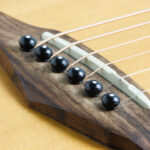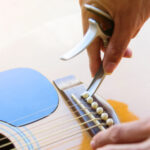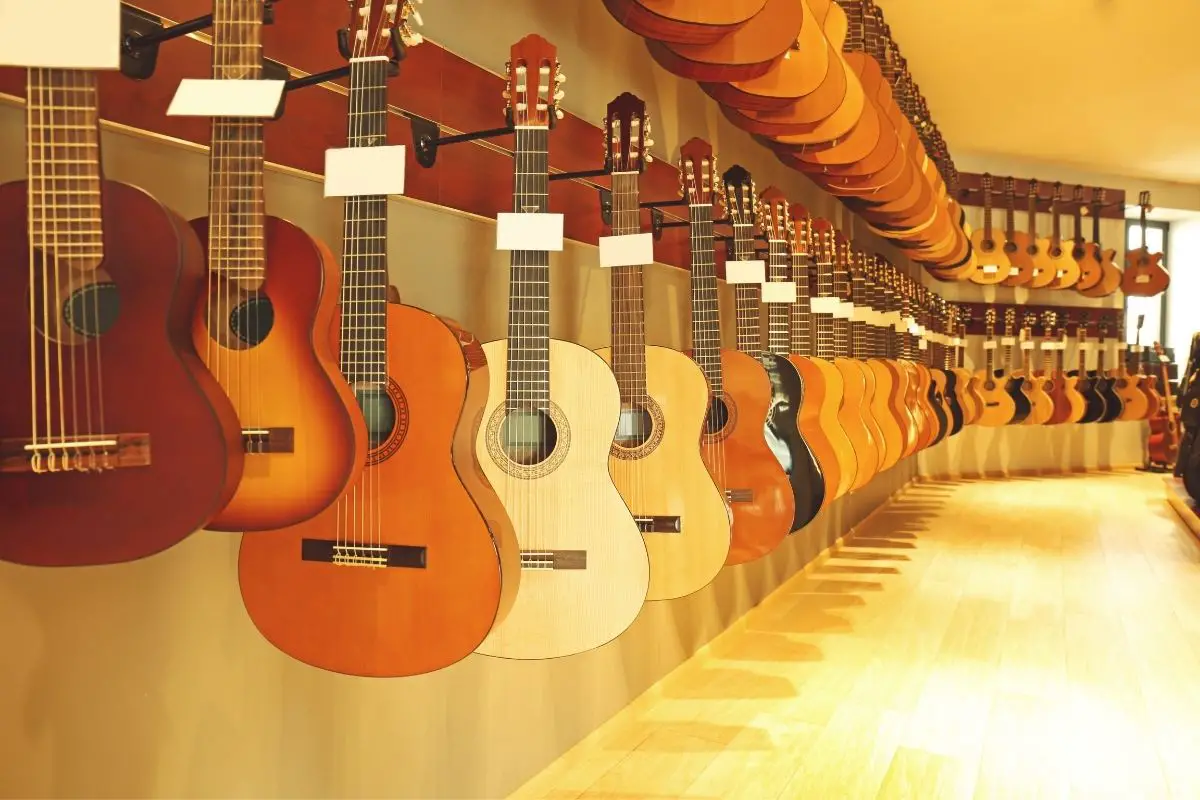Acoustic guitar players are always looking for ways to improve the sound of their instrument. One component that can make a significant difference is the bridge pins.
The bridge pins hold the strings in place and transfer vibrations from the strings to the guitar’s top, affecting the overall sound of the instrument.
When it comes to choosing the best material for acoustic guitar bridge pins, there are several factors to consider. The type of material can affect the sound, durability, and aesthetic appeal of the pins. Some materials may be more affordable than others, but may not offer the same quality or value for money.
Additionally, the installation and maintenance of the bridge pins can also play a role in the decision-making process.
Key Takeaways on Best Material for Acoustic Guitar Bridge Pins
- The type of material used for acoustic guitar bridge pins can affect the sound, durability, and aesthetic appeal of the instrument.
- Factors to consider when choosing bridge pins include affordability, quality, and ease of installation and maintenance.
- By understanding the different materials available and their impact on the instrument, guitar players can make an informed decision that meets their individual needs and preferences.
Check out this other popular post:
- 5 Best Bridge Pins For Acoustic Guitar
- Are Bone Bridge Pins Better Than Plastic?
- Do Acoustic Guitar Bridge Pins Make a Difference?
Understanding the Role of Bridge Pins in an Acoustic Guitar

Bridge pins are small but essential components of an acoustic guitar that hold the strings in place at the guitar’s bridge. They are typically made from various materials such as plastic, bone, ivory, brass, and wood. The choice of bridge pins can have a significant impact on the guitar’s tone and playability.
The primary function of bridge pins is to anchor the strings to the guitar’s bridge, transmitting the string vibrations to the soundboard, which produces the guitar’s sound. However, the material of the bridge pins can also affect the tone of the guitar.
Different materials have different densities, which can affect the transfer of energy from the strings to the soundboard.
For instance, denser materials like brass and bone can produce a brighter and more articulate sound, while lighter materials like plastic and wood can produce a warmer and mellower sound.
Furthermore, the material of the bridge pins can also affect the guitar’s sustain and volume. Harder materials like bone and brass can provide more sustain and volume, while softer materials like plastic and wood can produce less sustain and volume.
It is essential to note that the choice of bridge pins is not the only factor that affects the guitar’s tone.
Other factors such as the guitar’s body shape, wood type, and strings also play a significant role. Therefore, it is crucial to experiment with different bridge pins to find the best fit for your guitar and playing style.
Material Types and Their Impact on Sound
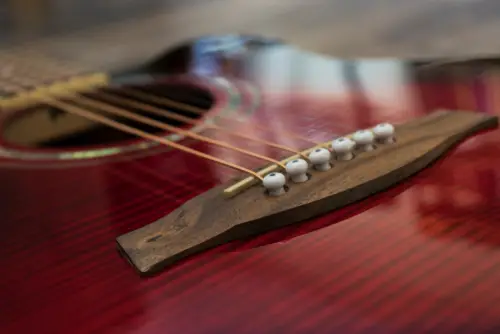
1. Plastic Bridge Pins
Plastic bridge pins are the most common type of bridge pins. They are inexpensive and easy to manufacture. Plastic pins are lightweight, which can lead to a brighter sound with less sustain. Plastic pins also have less tonal quality and resonance compared to other materials.
2. Bone Bridge Pins
Bone bridge pins are a popular choice for acoustic guitar players. They are known for their full and rich tone, with good sustain and clarity. Bone pins also add a noticeable amount of bass to the guitar’s sound. However, bone pins can be expensive and are not as durable as other materials.
3. Ebony Bridge Pins
Ebony bridge pins are a dense and heavy material that can produce a warm and full tone. They are known for their excellent sustain and clarity.
Ebony pins can also add a noticeable amount of treble to the guitar’s sound. However, ebony pins can be expensive and may require special care to maintain their appearance.
4. Brass Bridge Pins
Brass bridge pins are a popular choice for players who want a brighter and fuller tone. They are known for their excellent sustain and clarity, with a noticeable amount of treble and bass.
Brass pins can also add a noticeable amount of volume to the guitar’s sound. However, brass pins can be heavy and may require special care to maintain their appearance.
5. Ivory Bridge Pins
Ivory bridge pins are a rare and expensive material that can produce a warm and full tone. They are known for their excellent sustain and clarity, with a noticeable amount of bass.
Ivory pins can also add a noticeable amount of volume to the guitar’s sound. However, ivory pins are illegal to obtain and may require special care to maintain their appearance.
6. Tusq Bridge Pins
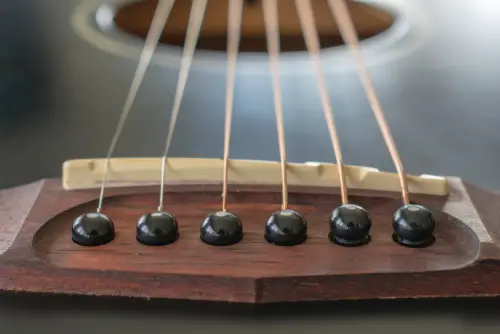
Tusq bridge pins are a synthetic material that can produce a bright and full tone. They are known for their excellent sustain and clarity, with a noticeable amount of treble and bass.
Tusq pins can also add a noticeable amount of volume to the guitar’s sound. However, tusq pins may not have the same tonal quality and resonance as natural materials.
7. Metal Bridge Pins
Metal bridge pins are a heavy and durable material that can produce a bright and full tone. They are known for their excellent sustain and clarity, with a noticeable amount of treble and bass.
Metal pins can also add a noticeable amount of volume to the guitar’s sound. However, metal pins can be heavy and may require special care to maintain their appearance.
8. Wooden Bridge Pins
Wooden bridge pins are a natural and warm material that can produce a full and rich tone. They are known for their excellent sustain and clarity, with a noticeable amount of bass.
Wooden pins can also add a noticeable amount of volume to the guitar’s sound. However, wooden pins may not have the same tonal quality and resonance as other materials.
9. Liquid Metal Bridge Pins
Liquid metal bridge pins are a new and innovative material that can produce a bright and full tone. They are known for their excellent sustain and clarity, with a noticeable amount of treble and bass.
Liquid metal pins can also add a noticeable amount of volume to the guitar’s sound. However, liquid metal pins can be expensive and may not be widely available.
Aesthetic Appeal of Different Bridge Pins
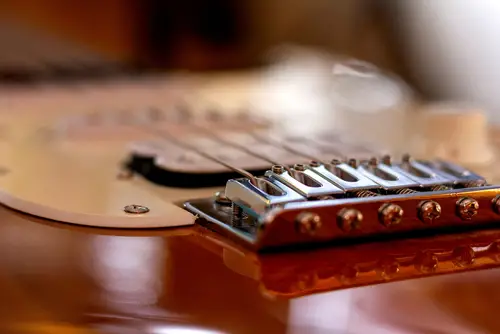
When it comes to choosing bridge pins for an acoustic guitar, aesthetic appeal is an important factor to consider. Different materials and designs can greatly affect the overall look of the guitar, and some players may prefer certain styles over others.
One popular option for bridge pins is abalone inlay. This type of pin features a small piece of abalone shell embedded in the top of the pin, adding a unique and eye-catching touch to the guitar.
Some players may prefer this type of pin for its elegant appearance, while others may find it too flashy for their taste.
Another option is abalone dot inlay, which features a smaller piece of abalone shell in the center of the pin. This design is more subtle than full abalone inlay, but still adds a touch of visual interest to the guitar.
Of course, there are also plenty of bridge pins available in more traditional materials, such as ebony, bone, or plastic. These pins may not have the same level of visual interest as abalone inlay, but they can still add a touch of elegance to the guitar and complement its overall aesthetic.
Ultimately, the choice of bridge pins will depend on the player’s personal preference and the overall look they are trying to achieve with their guitar.
Whether they opt for a flashy abalone inlay or a more understated ebony pin, the right choice can help enhance the guitar’s appearance and make it a joy to play.
Durability and Quality of Different Materials
When it comes to choosing the best material for acoustic guitar bridge pins, durability and quality are two important factors to consider. Different materials have varying levels of hardness, consistency, and strength, which can affect their durability and quality.
One popular material for bridge pins is bone. Bone bridge pins are known for their durability and consistency, as well as their ability to enhance the tone of the guitar. However, some players may find bone bridge pins to be too hard, which can cause damage to the bridge and the strings over time.
Another material that is commonly used for bridge pins is ebony. Ebony bridge pins are known for their high-quality and durability, as well as their consistent tone. However, ebony can be expensive and difficult to work with, which can make it less accessible to some players.
Plastic is also a popular material for bridge pins, as it is affordable and easy to work with. However, plastic bridge pins may not be as durable or high-quality as bone or ebony, and they may not provide the same level of tone enhancement.
Ultimately, the choice of material for acoustic guitar bridge pins will depend on the player’s individual preferences and needs. Each material has its own unique characteristics and advantages, and players should consider these factors carefully when making their selection.
Affordability and Value for Money

When it comes to choosing the best material for acoustic guitar bridge pins, affordability and value for money are important factors to consider. While some materials may offer superior sound quality, they may also come with a higher price tag.
One affordable option for bridge pins is plastic. Plastic bridge pins are widely available and can be purchased at a low cost. While they may not offer the same tonal qualities as other materials, they can still provide a decent sound and are a good option for those on a budget.
Another cost-effective option is bone. While bone bridge pins may be slightly more expensive than plastic, they are still relatively affordable and offer a warmer, more natural tone. They are also durable and can last for years with proper care.
For those looking for a budget-friendly option that still offers good sound quality, brass bridge pins may be a good choice. Brass pins are relatively inexpensive and offer a bright, clear tone that can enhance the overall sound of the guitar.
Ultimately, the best material for acoustic guitar bridge pins will depend on the individual’s budget and preferences. While some materials may offer superior sound quality, they may not be the most cost-effective option.
It is important to weigh the pros and cons of each material and choose one that offers the best value for money.
Installation and Maintenance of Bridge Pins
Installing bridge pins is a simple process that can be done with a few basic tools. The first step is to remove the old pins, which can be done by gently pulling them out with pliers. It is important to be careful not to damage the bridge or the surrounding wood when removing the pins.
Once the old pins have been removed, the new pins can be installed. For unslotted pins, simply push them into the holes in the bridge until they are flush with the surface. For slotted pins, insert the string into the slot and then push the pin into the hole until it is flush with the surface.
To ensure a tight fit, it may be necessary to sand the pins slightly. This can be done with a fine-grit sandpaper, being careful not to remove too much material. It is important to ensure that the pins are snug but not too tight, as this can affect the tone of the guitar.
Regular maintenance of bridge pins is important to ensure optimal performance. This includes cleaning the pins and the bridge regularly to prevent buildup of dirt and debris. It is also important to check the pins periodically to ensure that they are not loose or damaged.
Additional Factors Influencing the Choice of Bridge Pins
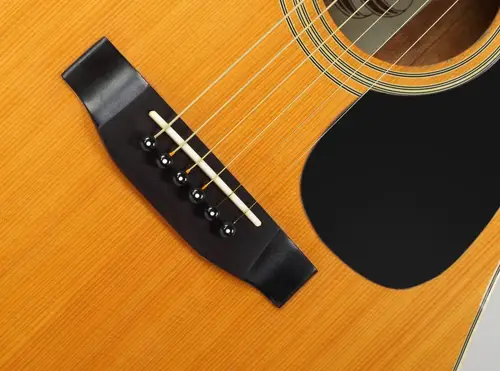
When selecting bridge pins for an acoustic guitar, several additional factors can influence the choice. These factors can include density, taper, action, vibration, saddles, bridge saddle, saddle material, and nuts.
Density is an important factor to consider when choosing bridge pins. The density of the material can affect the tone and sustain of the guitar. A denser material can produce a brighter and more focused sound, while a less dense material can produce a warmer and more mellow sound.
Taper is another factor to consider. The taper of the bridge pins can affect the fit and stability of the strings. A well-fit bridge pin can help to improve the tuning stability and sustain of the guitar.
Action is also an important factor to consider. The action of the guitar can affect the playability and feel of the guitar. A bridge pin that is too high can cause the strings to be too far from the fretboard, making it difficult to play. A bridge pin that is too low can cause the strings to buzz against the frets.
Vibration is another factor to consider. The vibration of the bridge pins can affect the tone and sustain of the guitar. A bridge pin that vibrates too much can cause the strings to buzz against the frets, while a bridge pin that does not vibrate enough can produce a dull and lifeless sound.
Saddles and bridge saddles can also affect the tone and sustain of the guitar. The material of the saddle can affect the brightness or warmth of the sound. A well-fit bridge saddle can help to improve the tuning stability and sustain of the guitar.
Finally, the material of the nut can also affect the tone and sustain of the guitar. A well-fit nut can help to improve the tuning stability and sustain of the guitar.
Product Recommendations and Reviews
When it comes to acoustic guitar bridge pins, there are a variety of materials to choose from. Here are some product recommendations and reviews for some of the best materials on the market:
1. Boxwood
Boxwood is a popular choice for bridge pins due to its durability and attractive appearance. Martin, a well-known guitar brand, offers boxwood bridge pins that are designed to enhance the tone of their high-end guitars. These pins are made from solid boxwood and are easy to install.
2. Chrome and Black Chrome

Chrome and black chrome bridge pins are a stylish option that can add a modern touch to any guitar.
The black chrome set from Martin Luxe is a popular choice for high-end guitars and offers a sleek, sophisticated look. These bridge pins are made from brass and are coated with black chrome for a durable finish.
3. Graphtech PP-1122-00 TUSQ
Graphtech’s TUSQ bridge pins are made from a synthetic material that is designed to enhance the tone of your guitar. These pins are easy to install and can provide a richer, louder sound than traditional plastic pins.
They are also more durable than bone or ivory pins and are a great option for players who want a more sustainable material.
4. Walrus Jawbone
Walrus jawbone bridge pins are a unique option that can add a touch of personality to your guitar. These pins are made from fossilized walrus jawbone and are known for their warm, rich tone. They are also a sustainable option, as the material is sourced from naturally deceased animals.
5. Zirconium Alloy
Zirconium alloy bridge pins are a high-end option that can provide a clear, bright tone. These pins are made from a durable material that is resistant to wear and tear, making them a great choice for players who frequently perform or travel with their guitar.
They are also available in a variety of colors, including gold, silver, and black.
6. Brass Pins
Brass bridge pins are a classic option that can provide a warm, mellow tone. These pins are easy to install and are a great choice for players who want a traditional look and sound. They are also available in a variety of finishes, including chrome, gold, and black.
7. Power Pins
Power pins are a unique option that can provide a louder, more resonant sound than traditional bridge pins. These pins are designed to transfer more energy from the strings to the guitar’s top, resulting in a fuller, richer sound. They are available in a variety of materials, including brass and zirconium alloy.
Frequently Asked Questions
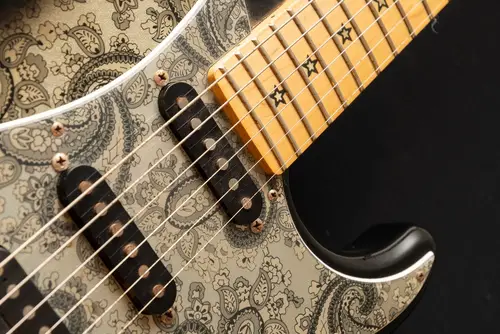
Which material is superior for acoustic guitar bridge pins?
There is no definitive answer to this question. Different materials have their own unique sound characteristics, and the choice ultimately depends on the player’s preference.
Some popular materials for bridge pins include bone, TUSQ, ebony, and plastic.
What are the advantages of using bone bridge pins?
Bone bridge pins are known for their clarity and sustain. They produce a bright and articulate sound that can enhance the overall tone of an acoustic guitar. Additionally, bone is a durable material that can withstand years of use.
Why are TUSQ bridge pins popular among guitarists?
TUSQ is a synthetic material that is designed to mimic the sound of bone. It is known for its consistency and reliability, making it a popular choice among guitarists who want a consistent tone from their instrument.
TUSQ is also resistant to wear and tear, which makes it a durable option for bridge pins.
What is the difference between ivory and bone bridge pins?
Ivory is a natural material that was once commonly used for bridge pins. However, due to conservation efforts, it is now illegal to trade ivory. Bone is a similar material that is often used as a substitute for ivory.
While the two materials have similar sound characteristics, bone is generally considered to be more durable and sustainable.
Do ebony bridge pins produce a better sound than plastic ones?
Ebony is a dense and hard wood that is known for its clarity and sustain. It can produce a warm and rich sound that is favored by some guitarists. Plastic, on the other hand, is a more affordable option that can produce a decent sound.
Ultimately, the choice between ebony and plastic depends on the player’s preference and budget.
Are there any drawbacks to using bone bridge pins on an acoustic guitar?
One potential drawback of bone bridge pins is that they can be more expensive than other materials. Additionally, bone is a natural material that can vary in quality from batch to batch.
However, these drawbacks are relatively minor compared to the benefits that bone can provide in terms of tone and durability.

My name is Howard Matthews and I have been playing the guitar since I was knee-high. My parents like to joke that I was pulling the strings even before I was born. In fact, one of my earliest memories is sitting on the couch with my dad’s guitar, wreaking havoc on the chords.
Now, 40 years later, I can attest that I play them much better than I did back then. I have followed in the footsteps of both my parents – much to their delight – and have been the main guitarist in my band for the best part of three decades.
Music has always been my passion, and until recently my life has been so consumed with it that I haven’t had a moment to have a breath (and I wouldn’t have it any other way)!


